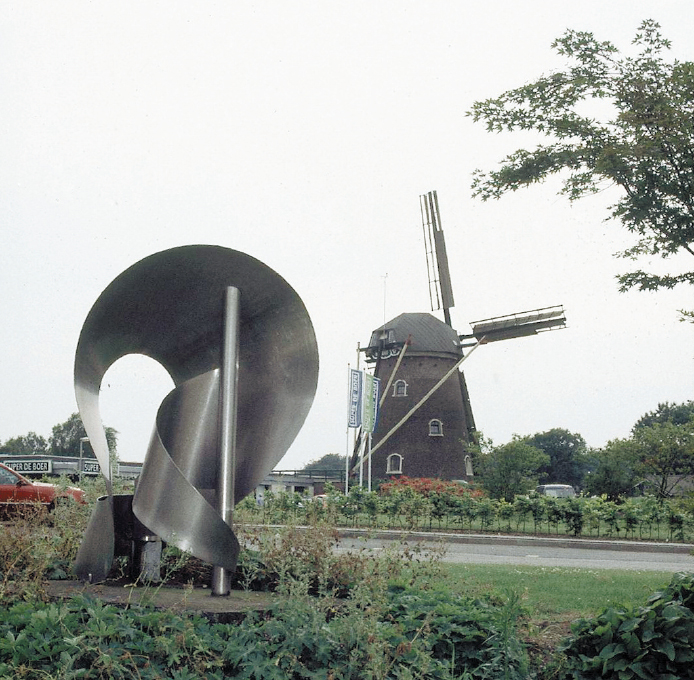THE GROESBEEK CIRCUIT: XXX CORPS, CANADIANS & US AIRBORNE
•Itinerary Three starts at the Nijmegen Bridge, heads east to Beek via Ooij, climbs to Berg en Dal and Groesbeek, through the American DZs and LZs and General Browning’s landing site and returns back to Nijmegen via civilian memorials and CWGC cemeteries.
•The Route: Nijmegen Bridge; Ooij Civilian Memorial; Beek - ‘Devils in Baggy Pants’ Memorial, Civilian Memorial, Lt J. Foley Sign; Berg en Dal Civilian Memorial; Sionshof 508th Bas Relief; Groesbeek - Canadian CWGC Cemetery and Memorial to the Missing, 508th PIR DZ T/Operation VERITABLE Start Point, Wylerbaan, National Liberation Museum, Canada-Netherlands Memorial Park, Monument near South Mill, General Gavin/82nd US AB Monument; Breedeweg - Site of General Browning’s HQ, Plaques to 505th PIR, St Antonius Church; Klein Amerika - Monument to 505th PIR DZ N/General Gavin’s Landing/General Crerar’s 1st Canadian Army, German Concrete Bombs; St Jansberg Plaque to Crew of Halifax; Milsbeek - CWGC Cemetery, Civilian Memorial; Mook - CWGC Cemetery, Monument to Civilian Casualties, RC Churchyard; Site of Allied 1944 Cemetery, Van den Broek Brewery.
•Extra Visits are suggested to Cuijk - Polish Sculpture to Civilian Casualties, Memorial to Jewish Casualties; Katwijk Monument to Dutch Soldiers, 1940; Linden Churchyard Plaque to C-47 Skytrain/James Martin; Nijmegen - site of 82nd and 101st AB Hospitals.
•Planned duration, without stops for refreshment or Extra Visits: 4 hours 30 minutes.
•Total distance: 56.8 kms/35.5miles
•Keizer Traianus Plein, Nijmegen/Okms/0 miles
From the Nijmegen Bridge take the N325 signed Kleef(Kleve).
This is the important main road into Germany, which is just 10kms away, and control of the road was a priority task of 508th PIR, though it was not achieved until the morning of 18 September. In the heights to the right was a vast Roman fortress, large enough to hold an entire Legion. See Update Page xxi about the road changes which affect Itinerary 3.
Continue, with the rising ground of the Groesbeek Heights on the right, to the left turn signed Ooij and turn left at the traffic lights.
The church visible to the left is at Persingen, the smallest community in Holland.
Continue, turn left into Ooij and stop by the church on the left.
• Memorial to Ooij Civilians/6.6 kms/4.1 miles/5 minutes/Map 1N/9
The handsome bas relief of St George and the Dragon memorial is built into the church wall. It was erected on 4 May 1989, and the panels flanking St George bear the names of the twenty civilians killed in the cellars of the Scheers’ café on 28 September 1944 when a German fighter-bomber dropped two bombs on it after being hit. The other names are of those who lost their lives on the Grebbeberg in 1940, during the bombardment of Nijmegen and after the war by a landmine. New names have recently been added to the panels. There are some Dutch Wargraves in the adjoining cemetery.
Return to the junction with the N325 and go straight over into Beek. Turn right following Doorgaand Verkeer and stop opposite the memorial on the left just before the T-junction.
• Memorials to the 508th PIR, 82nd US AB Div, Beek Civilians and Lieutenant John Foley/9.9 kms/6.2 miles/10 minutes/Map 6-29/30
The ‘Devils in Baggy Pants’ Memorial, designed by H.J. Guse, was erected on 17 September 1981. It commemorates the liberation of Beek by the 508th PIR, known as the ‘Red Devils’, on 17 September 1944. In C Company of the Regiment (American Parachute Infantry Regiments were roughly of the same strength as British Parachute Brigades) was First Sergeant Leonard A. Funk who would return to Pennsylvania as the most decorated American paratrooper of the war. The bas relief of a baggy-panted devil descending by parachute originates from an entry in the diary of a German officer who fought against American paratroopers (actually the 504th) at Anzio. It read:
American parachutists - devils in baggy pants - are less than 100m from my outpost line. I can’t sleep at night; they pop up from nowhere and we never know when or how they will strike next. Seems like the black-hearted devils are everywhere.
In 1944 Beek, which sits astride the Nijmegen-Kleve road, had to be taken to gain control of the road. Although the monument records Liberation as 17 September, 508th PIR had so many varied tasks that it did not gain full control of Beek until 21 September, up to when it changed hands several times.
Next to the 508th Memorial is the local War Memorial which records the names of forty-two civilians, including Ruth Jakobs, a Jewish lady, killed by a shell after the Liberation in October, whose diary was published in 1999.
Beyond it is a sign to ‘Lt. John P. Foley of ‘A’ Coy, 508th PIR’. On 19 September the company was ordered to take the Duivelsberg, the heights beyond Beek. Foley and his forty-four men were cut off for five days and nights (although he was resupplied with ammunition by American patrols), but held the position until relieved.
Continue to the T-junction and turn left. Continue through the charming village of Beek and then at the VVV in the old electricity company building turn right uphill towards Berg en Dal.
The building on the left at the bottom of the hill is the old customs house. Beek was formerly a border town between Holland and Germany. The hill you are ascending is the Duivelsberg (Devil’s Hill). There are still the remains of 1944/45 trenches in the woods here.
At the top turn left signed Groesbeck and Kleef Turn right at the green CWGC Groesbeek Cemetery sign and continue 50m to the column on the right.
• Memorial Column to Berg en Dal’s Liberation and Civilian Casualties/11.8 kms/7.4 miles/5 minutes/Map 6/31
Erected on 5 May 1955, this memorial on the summit of the Duivelsberg is in gratitude to its liberation and to commemorate the fallen of Berg en Dal, 1940-1945. By a curious coincidence, bearing in mind the possible connection between the launch of the V2 rockets on London and the inception of MARKET-GARDEN, SS General Hans Kammler, who was in charge of the V2 programme, had his HQ in the town. Following the 17 September landings he immediately moved out of Holland both his HQ and the 485th Battalion of Group North (near the Hague) which had done the firing. This might therefore be accorded as a partial success for MARKET-GARDEN - though the rockets were back in under two weeks. Heavy fighting took place here and not only were there many casualties but enormous damage to buildings and land. In November 1944 the inhabitants were evacuated and when they returned not one house appeared to be undamaged.
Continue down Clarenbeeksweg, following the road round to the right signed Heiligland Stichting (Holy Land Foundation) and Afrika Museum. Continue past the Afrika Museum on the left then the Holy Land Open Air Museum on the right.
In the grounds of the latter is a Memorial Chapel to Dr Daniel van Vugt, (Map 6/28) one of approximately twenty war victims buried in the Holy Land Foundation churchyard. It is occasionally used for commemorations of the fallen and bears plaques to Dr van Vugt (imprisoned because of his work for the Resistance), who died in the German concentration camp at Sandbostel on 2 May 1945. There are also tablets to three policemen shot by the Germans on 6 June 1944 at Overveen. The 508th took control of the Foundation grounds.
Continue to the roundabout, go straight over and stop outside the Sionshof Hotel.
• Sionshof Hotel 508th PIR Memorial/Nebo Seminary/15 kms/9.4 miles/10 minutes/Map 6-27/26
By September 1944 the Sionshof had been used for four years by the Germans as an HQ. They also used the Klooster Nebo, the large Catholic Seminary across the road, both of which were taken over by the advancing Allies’ War Correspondents and photographers who arrived by glider. Guards Armoured Division Officers moved into the hotel, to be followed by 82nd AB. Here the Dutch liaison officer, Captain Harry Bestebreurtje, made contact between the Allied Forces and the local forces and sent a patrol into Nijmegen to recce the situation near the Waal bridge. Prince Bernhard of the Netherlands lunched here in September 1944. Prior to MARKET-GARDEN the Seminary was used by the staff of a German parachute training school, evacuated from France. It was then used as a combined hospital (treating German POWs until as late as 1946), prisoners’ interrogation centre and GHQ. The garden was used as a temporary cemetery. Behind the building an American medium battery pounded German positions in the Reichswald Forest. On the outside wall of the Sionshof is a Memorial Bas Relief to 82nd AB Division designed by Ch. Hammes. It depicts a paratrooper of the 82nd AB Division. It was presented by the municipality of Nijmegen to the Sionshof Hotel and unveiled on 17 September 1954 by Major Bestebreurtje. The No. 17 and one of the small parachutes is, sadly, missing. Inside the hotel are more details.
The sensitively written novella, Five Graves at Nijmegen, by the Australian correspondent calling himself Eric Baume, described the graves of ‘five British Guardsmen, officers and other ranks’ in the Nebo grounds. Baume was in the Sionshof during the Operation and talked at length to one of the Franciscan friars, Aurelius Pompen. This conversation was the basis of his book. A sketch accompanied the text which was later shown to have been taken from a photograph. The five white crosses stand around a large ornamental cross and are surrounded by a white wooden fence. Research by Father Thuring (qv) and J. Hey (qv) points to the fact that one of the graves - of which there were actually a total of twenty-three - belongs to a Scots Guardsman Andrew Wardrope who was badly wounded when his tank was brewed up on the Wylerbaan on 8 February 1945. He was brought to the hospital here and died on 11 February. Another identified grave belonged to Captain the Hon Vicary Paul Gibbs (qv), killed at the Valkhof on 20 September 1944. They are both now buried in Jonkerbos CWGC Cemetery [22.B.4. and 22.G.4.].

St George and Dragon Memorial to Ooij’s Civilians
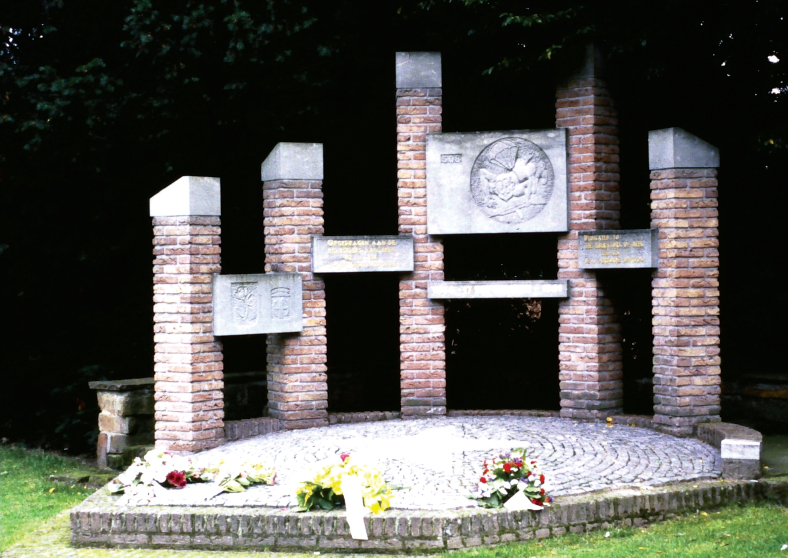
‘Devils in Baggy Pants’ Memorial, Beek

508th PIR Memorial, Sionshof Hotel
Turn round, turn right and continue towards Groesbeek. Turn left along Derdebaan signed to the Canadian Cemetery and continue to the left turn to it. Stop in the car park.
• Groesbeek Canadian CWGC Cemetery/Memorial/19.2 kms/12 miles/20 minutes/Map 6-32/33/OP
The cemetery is on the highest point for several kilometres and affords an excellent view over the 82nd AB drop and landing areas.
Walk into the cemetery and stand with your back to the Cross of Sacrifice, facing the open fields away from the entrance.
That is 12 o’clock. The Nijmegen road bridge is 7kms away at 7 o’clock, the Arnhem road bridge 19kms away at 9 o’clock. The German Border and Reichswald Forest can be seen 5kms away at 2 o’clock, Groesbeek is 2kms away at 3 o’clock and the Grave Bridge is 13kms away at 5 o’clock [Bridge 11 - see Sketch Map 3]. 82nd AB had two main DZs, one at Grave and one here. 508th PIR came down in the area from your left sweeping round to about 2 o’clock. Between them and the Reichswald 505th PIR commanded by Colonel William E. Ekman dropped, their area curving to the south of Groesbeek. Part of their task was to protect the area for the D+1 follow-up glider landings. Within 60 minutes the paratroopers were moving off to their objectives, some climbing the slope towards you en route to Nijmegen. Patrols were sent into the forest which, rumour had it, concealed German tanks - Gavin’s map recorded ‘May be pool for refitting Panzer Divs’. The rumour proved to be false. The landings were largely unopposed. One C-47 was hit by flak, too low for the paratroopers to jump. It made a perfect wheels-up landing, on the site of the present cemetery, and the men walked out of the plane.
Originally there were fairly advanced plans to create several small Canadian cemeteries, notably at St Michielsgestel Seminary and in Angerlo RC Cemetery. Finally, however, it was decided to concentrate the Canadian burials here at Groesbeek from a host of small (some with only a handful of graves) burial grounds. The meticulous and laborious work started in August 1945 and continued into the spring of 1946. The cemetery contains 3 RN, 212 UK Army and 10 Unknown, 40 RAF and 3 Unknown, 2,190 Canadian Army and 4 Unknown, 141 RCAF and 3 Unknown, 2 RAAF and 1 NZAF, 3 Belgian, 1 Dutch, 2 Polish, 1 Russian and 1 Yugoslav. The majority lost their lives in the Battle of the Rhineland, when 2nd and 3rd Canadian Divisions and 4th Canadian Armoured Division took part in the drive southwards from Nijmegen to clear the territory between the Maas and the Rhine in February/March 1945.
The VC was awarded to Sergeant Aubrey Cosens, RCIC, age 24, 26 February 1945 [VIII.H.2.]. His citation in the London Gazette reads,
In Holland, on the night of 25/26 February, 1945, the 1st Battalion The Queen’s Own Rifles of Canada attacked the hamlet of Mooshof. Sergeant Cosens’ platoon, with tanks in support, had as their objective enemy strong-points in three farm-buildings. They were twice beaten back and were then fiercely counterattacked. Their casualties were heavy, including the platoon commander killed. Sergeant Cosens assumed command of the few survivors of the platoon, and placed them so as to give covering fire while he crossed open ground to the one remaining tank and directed its fire. After a further counter-attack had been repulsed, Sergeant Cosens ordered the tank to attack the three farm-buildings, the remaining men of his platoon following in close support. He himself entered the three buildings in turn, alone, and killed or captured all the occupants. Immediately afterwards he was shot by a sniper, and died almost instantly. His outstanding gallantry, initiative and determined leadership resulted in the capture of a position which was vital to the success of the future operations of the Brigade.
The MC was awarded to Lieutenant Donald Ayer, RCAC, age 32, from Maine, USA, 4 March 1945, [VII.E.3.]; Captain Harvey Bean, RCIC, age 23,14 February 1945 [I.D.5.]; Major George Skelton, 3/4th County of London Yeomanry, age 27, 28 February 1945 [VI.F.7.].
The MM and Bar was awarded to Corporal Stanley Matchwick, 5th Seaforth Highlanders, age 39, 25 March 1945 [VI.B.12.]. The MM was awarded to Rifleman Charles Nahwegezhic, RCIC, age 26, 28 February 1945 [XVI.G.l.]
The DSO was awarded to Major Samuel McWhirter, RCA, age 36, 9 February 1945 [I.B.I.]; Lieutenant-Colonel John Rowley, Commanding the North Shore (New Brunswick) Regt, age 33, 26 March 1945 [XVII.E.15.]; Private Harold Schultheis, RCIC, age 22, 8 March 1945 [IV.F.15.] and Major Latimer Denison, Royal Winnipeg Rifles, age 24, 30 March 1945, who also had the Croix de Guerre [XX.G.12.]. Major Willard Parker, RCIC, age 29, 26 February 1945 also had the Croix de Guerre [IX.H.6.]; Lieutenant-Colonel Ernest Thompson, RCIC, age 24, 26 February 1945 [IX.B.16.]
The DFC was awarded to Flight Lieutenant Russell Bouskill, RCAF, age 28, 2 October 1944 [XV.E.5.] and Pilot Officer Cecil Hightower, RCAF, age 32, 26 July 1943 [XVI.B.14.]; Captain William Reade, RCAC, age 31, 23 April 1945 [VIII.A.8.]; Flight Lieutenant William Hodgson, RAF, age 24, 27 December 1944 [XII.F.6.], who also had the AFM; Squadron Leader William Klersy, RAF, age 22, 22 May 1945 [XXI.E.15.], who also had the Bar.
The DFM was awarded to Pilot Officer David Crozier, RCAF, age 28, 13 January 1943 [XV.A.7.]. The MBE was awarded to Wing Commander John Brown, 1 September 1944 [VI.G.12.]. The OBE was awarded to Lieutenant-Colonel Jeff Nicklin, 1 Can Para, age 30, 24 March 1945 [XXII.C.l.].
MiD were Lieutenant Francis Arnett, RCAC, age 29, 25 March 1945 [XV1.C.11.]; Lance Sergeant Edward Bellows, 14 Field Sqn, RCE, age 27,18 May 1945, who also had the Croix de Guerre avec Etoile de Bronze [IV.A.13]; Captain Reginald Boyce, RCA, age 26, 26 February 1945 [X.C4.]; Major Armand Brochu, RCIC, age 30, 1 March 1945 [VIII.D.14.]; Captain Geoffrey Gibbs, 3rd Monmouths, age 29, 30 November 1944 [XII.H.6.]; Lieutenant-Colonel John Hall, Commanding the 1st Middx, age 35, 8 February 1945, who also had the Croix de Guerre [VI.H.3.]; Private Harold Schultheis, RCIC, age 27, 7 February 1945 [IV.F.15.]; Bombardier Douglas Trumper, RCA, age 26, 2 March 1945 [XIV.F.13.].
Lieutenant-Colonel Ralph Stockley Commanding the 3rd Monmouths, age 37, 30 November 1944 [XII.H.8.] was the son of Brigadier-General Hugh Stockley, CIE, RE. The Rev Joseph Dalcourt, Chaplain 3rd Class of the Canadian Chaplain Service, died on 28 February 1944 [IX.E.14.].
The brothers of the following also fell on service: Private Bruce Wagner, RCIC, age 20, 31 January 1945 [XVI.C.3.], Private Ivan Wagner, RCIC, age 27, 18 July 1944, buried in Bretteville-sur-Laize, Normandy and Private Harry Wagner, RCIC, age 30,12 August 1944, buried in Bény-sur-Mer, Normandy; Sergeant Alan Horsfall, RAF, age 19, 30 August 1940 [XII.H.9-11.], Sergeant David Horsfall, RAF, age 23,17 May 1943, buried in Bergen General Cemetery; Trooper Harold Illingworth, RCAC, age 27, 26 February 1945 [IX.F.l.], Private Charles Illingworth, RCIC, age 22, 4 December 1944, buried in Ravenna CWGC Cemetery, Italy; Lieutenant Daniel Paré, age 24, 16 January 1945 [I.D.10.], WOII Viateur Paré, RCIC, age 27, 6 April 1945, buried in Holten Can Cemetery, Holland.
Private Ralph Ash, [XIV.D.9.] and Private Bruno Boutet [XXV.A.4.], who were both in the RCIC and died on 2 March 1945, were 17 years old, as was Private Herbert Danielson, Black Watch of Canada, 9 March 1945 [VIII.E.6.] and Private Barney McGuigan, RCIC, 26 February 1945 [X.G.6.], while Trooper John Bartlett, RCAC, 27 February 1945, was 48 years old [XXI.G.2.].
There are five members of the Belanger family, including brothers Craftsman Conrad, RCEME, age 26, died on 2 April 1945 [V.E.9.] and Private Jean Paul, RCIC, age 23, died on 24 February 1945 [XI.C.3.]. Albert Saunderson, RN, age 20, 9 August 1945 [VI.C.2.], was ‘Coder’ on HMS Odyssey.
Flying Officer A. F. Hupman, Nav RCAF, and Flying Officer D Morrison, RCAF, [both in Coll Grave XV.C.3], Pilot Officer G. E. Quinn, RCAF [XX.A.l.], Pilot Officer C. S. Johnston, RCAF [XV.C.l.], Pilot Officer H. Fletcher, RCAF [XV.C.2.] and Pilot Officer P. J. McManus, RCAF [XV.C.4.] are all on the Lancaster Memorial in Elden (qv).
In the cemetery stands
The Groesbeek Memorial. Servicemen who fell at Arnhem and who have no known name are recorded on this Memorial.
The Memorial consists of two L-shaped buildings, facing each other across the turfed forecourt between the cemetery entrance and the Stone of Remembrance. The names of the Missing are inscribed on Portland stone panels along the back walls of each structure, with the legend,
These walls bear the names of the soldiers of the Commonwealth who fell in the advance from the River Seine through the Low Countries and into Germany, but of whom the fortune of war denied a known and honoured grave. 30 August 1944 - 5 May 1945.
On the friezes above the columns is carved the inscription, ‘Pro Amicus mortui amicis vivimus’ [We live in the hearts of friends for whom we died] and the names of the great rivers which marked the progress of the campaign: ‘Seine, Scheldt, Maas, Rhine, Elbe.’
The names are made up as follows: 951 United Kingdom, 103 Canadian and 2 South African. There are 178 names of the Parachute Regiment, 83 Royal Artillery, 67 Royal Engineers, 47 RASC, 33 Border Regiment, 31 KOSB, 30 Wiltshire Regiment, 24 DCLI, 20 HLI and 20 S Staffs Regiment, with representatives of 79 other UK Corps and Regiments and 34 Canadian Corps and Regiments.
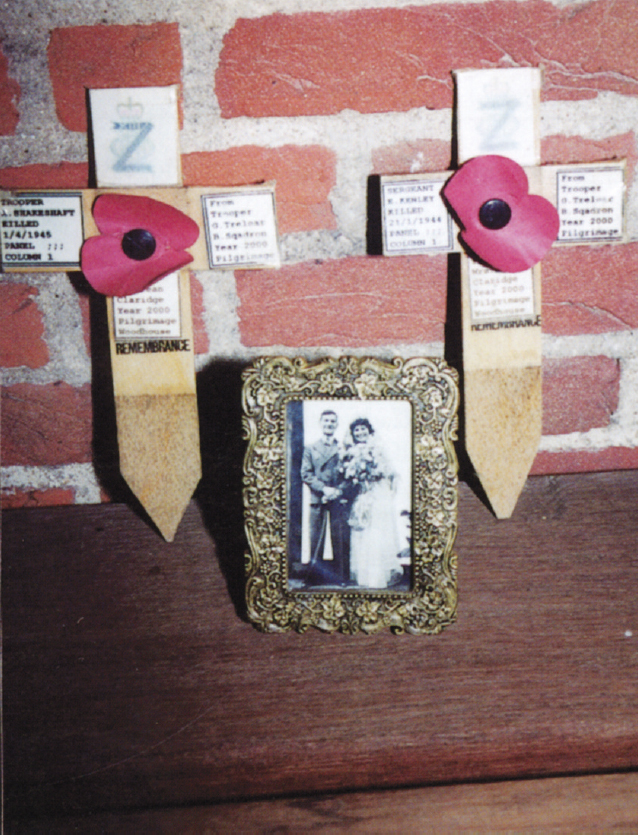
Groesbeek CWGC Cemetery and Memorial: Personal Tribute, Row of headstones
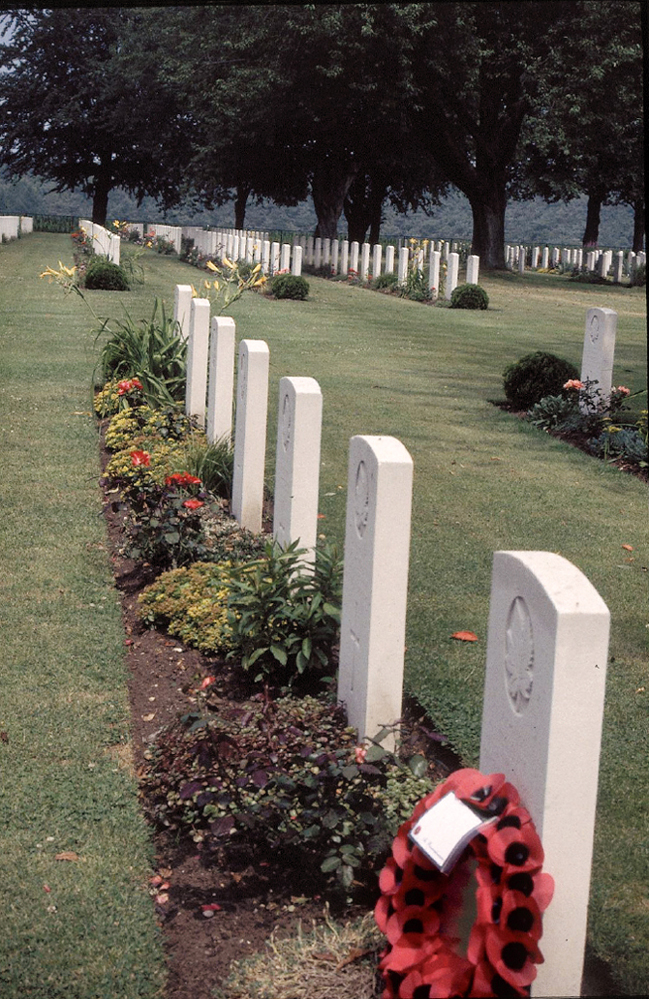
N.B. There is a separate register for the Memorial, housed in the right hand building.
The VC was awarded to Lance-Sergeant John Baskeyfield, 2nd Battalion, S Staffs Regt, 1st AB Division, age 22, 20 September 1944. His citation in the London Gazette reads,
On 20th September, 1944, during the Battle of Arnhem, Lance-Sergeant Baskeyfield was the N.C.O. in charge of a 6-pounder anti-tank gun at Oosterbeek. During the early stages of a heavy enemy attack, the crew commanded by this N.C.O. were responsible for the destruction of two Tiger tanks and at least one self-propelled gun, thanks to his coolness in allowing each tank to come well within 100 yards of his gun before opening fire. Lance-Sergeant Baskeyfield was badly wounded and the remainder of his crew were either killed or severely wounded but he refused to be carried away from his post, and when the attack was renewed he manned his gun alone and fired round after round until his gun was put out of action. His activity was the main factor in keeping the German tanks at bay, and his example and his courage were responsible for keeping together and in action the surviving men in his vicinity. When his gun was knocked out, he crawled to another nearby which was left without a crew, and succeeded in putting out of action another self-propelled gun before being killed. Lance-Sergeant Baskeyfield’s supreme gallantry is beyond praise. During the remaining days at Arnhem stories of his valour were a constant inspiration to all ranks.
See page 237 Itinerary 5.
The MC was awarded to Lieutenant Bertram Horwood, 12th (AB) Bn, Devonshires, age 21, 6 February 1945 [Panel 3]. The MM was awarded to Corporal Edward Browne, 2nd R Warwicks, age 26, 30 September 1944 [Panel 3].
MiD were SQMS George Holderness, RAC, age 30, 25 September 1944 [Panel 1]; Lieutenant Leslie Kershaw, Cheshire Regt, age 27, 12 April 1945 [Panel 3); Captain Percy Louis, RAMC, age 29, 24 September 1944 [Panel 3]; Captain Francis Smith, RE, age 46,16 December 1944 [Panel 2]; Corporal Richard Verling, RE, age 27, 22 November 1944 [Panel 2]; Corporal Albert Wicker, RE, age 28, 31 March 1945 [Panel 2]; Major Ernest Ritson, 156th Para, age 35, 20 September 1944 [Panel 8] was Twice Mentioned.
The DSO was awarded to Major Gustave Bieler, RCIC, 5 September 1944 [Panel 11], who also had the MBE; Major Francis Suttill, East Surreys, age 35,18 March 1945 [Panel 4], who was ‘LL.B. (Lond.) Barrister-at-Law’.
The OBE was awarded to Colonel Hilary Barlow (qv) of the SLI, Commanding 1 Airlanding Bde, AAC, 19 September 1944 [Panel 1.]. The BEM was awarded to Lieutenant Stanley Watling, 156th Para, age 28,19 September 1944 [Panel 8]. The Croix de Guerre was awarded to Captain Frank Pickersgill, Can Int Corps, age 29,14 September 1944 [Panel 11]. The King’s Commendation for Brave Conduct was awarded to Serjeant Peter Weisz, Int Corps, age 24,1/30 April 1945 [Panel 10].
Private Timothy Bleichroeder of 21st Indep Para Coy, age 22, 25 September 1944 [Panel 9], served as ‘Bleach’. Private Herbert Sachs, The Buffs/10 Commando, age 27, 23 March 1945 [Panel 3], served as ‘Seymour’. They were two of the approximate 15,000 German Jews serving with the British Army.
The father of Lance-Corporal William Eden, Border Regt, 1 AB Div, age 29, 22 September 1944, [Panel 4], Private John Eden, KORR, age 27, died of wounds from Gallipoli on 24 August 1915 and is buried in Alexandria, Chatby. The father of Lance-Corporal David Jones, The Welch Regt, age 30, 24 September 1944 [Panel 5], Private Thomas Jones of the same regiment, was also killed in Gallipoli - at Suvla Bay - on 11 August 1915 and is commemorated on the Helles Memorial. The father of Private David McKenzie, 10th Para Bn, AAC, age 23, 20 September 1944 [Panel 9], Gunner Kenneth McKenzie, RA, age 45, was killed in action in London 17 January 1943 and is buried in Dundee Eastern Necropolis. The father of Lieutenant Robert McLaren, RA, age 30, 18 September 1944 [Panel 1], Private Peter McLaren, Bedforshire Regt, age 33, died of wounds in Belgium on 24 October 1917 and is buried in Mendinghem cemetery.
The brothers of the following also fell on service: Gunner Arthur Lock, RA, age 24, 20/21 September 1944 [Panel 2], Gunner Libert Lock, RA, age 27,16 August 1941, buried in Candlesby, Lincs and Gunner Wilfred Lock, RA, age 30,16 January 1943, buried in Heliopolis, Egypt; Driver George Essen, RASC, 28 April 1945, [Panel 9], Sapper Charles Essen, age 20, 17 June 1940, buried in Pornic War Cemetery France, who was probably a casualty of SS Lancastria; Driver Ernest Page, RASC, age 46, 2 November 1944 [Panel 9], Driver Charles Henry Page, age 22, 24 February 1945, buried in Jonkerbos CWGC Cemetery [5.F.3.]; Guardsman John Thornley, 3rd Irish Guards, age 20, 1 October 1944 [Panel 3], Guardsman Allan Thornley, 3rd Irish Guards, age 19, 7 June 1943, buried in Liverpool (West Derby) Cemetery.
Gunner Cecil Riggs, RA, age 23, was lost in SS Samvern (London) 18 January 1945 [Panel 2].
Return to Derdebaan crossroads.
The farm on the corner was used by General Horrocks as his HQ at the start of Operation VERITABLE.
Turn left past the cemetery and continue to the junction with Wylerbaan. Stop just before it. Round the corner to the right is
• Memorial to 508th PIR Landings/Operation VERITABLE, Wylerbaan/20.8 kms/13 miles/5 minutes/Map 6/34
Shaped like an airborne canister or the Tinman in the Wizard of Oz, this metal memorial records, on the back, the fact that here on 17/18 September 1944 Red Devils of 508th PIR landed with artillery by parachute and glider.’ Devils or Angels, they came to shield the district of Nijmegen. Pilgrim - no matter the name or the colour, shield the vulnerable’. On the front is recorded,
From this point around 300,000 British and Canadian soldiers set off on Monty’s Operation VERITABLE. Pilgrim, strive with whatever it takes to realise your ideals. 16 September 1990.
It was erected by C.Hectors, A. van Grinsen and Father Thuring (qv).
• Extra Visit to Germany to Memorial to Shot Americans, Kranenburg (Map IN/10) and German Cemetery, Donsbruggen (Map 1N/11) Round trip approximately 25 kms/15.6 miles). Approximate time: 40 minutes
Turn left on Wylerbaan and continue to Wyler. Turn right and follow directions Kleve and Kranenburg into Germany. Continue into Kranenburg to the small Market Square to the left (5.1 km/3.2 miles).
To the right is the Roman Catholic Church behind which is a large black crucifix Tree of Life Memorial with a table showing a map of the 1944/45 campaigns in the area and a skull and bones at the base.
Continue through the town to just short of a BP petrol station to the left and the Town Hall and VVV to the right. Stop (5.4 kms/3.4 miles).
On the left corner by a lampost is a black Memorial Bas Relief with a brick base.
The bas relief is flanked by two angels and shows a lily with a chain and the words ‘HASS TÖTET LIEBE VERSÖHNT [Hate kills. Love reconciles] 17.9.1944’. The caption below describes how on the day of the Allied Landings two American Prachutist POWs were shot on this spot, in cold blood, by an SA man. Their deaths were later investigated by an Allied Military Court.
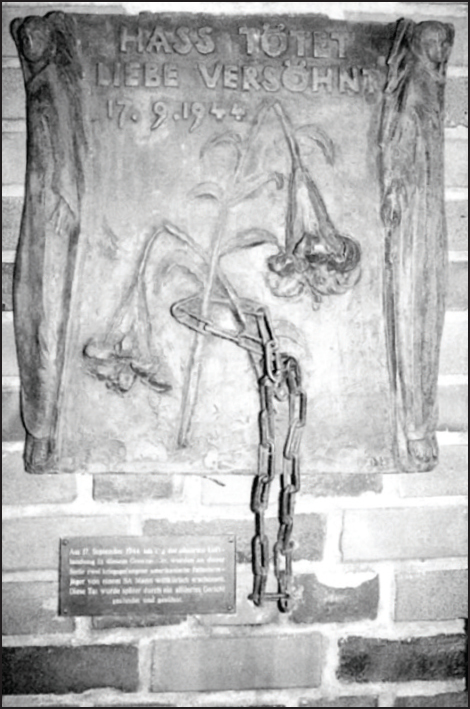
This is an extremely rare memorial.
Continue to Nutterden.
In front of Nutterden Church to the left is the local War Memorial with the names of the Missing.
Continue to the green sign to ‘Kriegsgräbestätte 700m’ to the right. (11.3 kms/7.1 miles). Turn here and follow a second sign to the right (at 240m) and turn right at the third (185m) sign to the large car park in front of the cemetery and stop.
Donsbruggen German Cemetery (12.5 kms/7.8 miles). A large signboard describes the 2,381 graves here, 40 of them Unknown, of the February 1945 fighting.
Go up the steps to the stone-enclosed cemetery.
The Register box is to the left of the entrance and ahead is the crypt with the names of the Unknown surrounded by a mass grave. The markers on the graves are flat and are interspersed with symbolic crosses.
Return to your car and back to Wylerbaan to pick up the main Itinerary.
Turn right along Wylerbaan and continue towards Groesbeek.
The row of trees to the left leads to the farmhouse Den Heuvel (Map 6/35), where bitter fighting took place. The road passes through DZ T where 508th PIR and a company of the 505th, dropped. To the left were German trenches and machine-gun nests in January/February 1945 and on the right can be seen WW2 metal pickets and concrete bombs (qv).
Continue to the National Liberation Museum 1944 on the left and stop in the car park.
• The National Liberation Museum 1944, Groesbeek/Sherwood Rangers Memorial Sherman/German 75mm Gun/Canada-Netherlands Memorial Park/22.4 kms/14 miles/45 minutes/Map 6-37/37a/38/39/36
Inaugurated on 6 May 1987 by HRH Prince Bernhard of the Netherlands, the museum was funded and realised by enthusiastic American veterans and Dutch volunteers. Built on the spot where General Gavin’s 82nd AB landed on 17 September 1944, it has two aims: to keep alive the memory of the crucial events of 1944/45 and to express gratitude to those who gave their lives for the freedom of this part of Holland.
In 2000 the museum underwent a huge renovation and expansion programme, the focal point of which is a vivid diorama, an accurate portrayal of the Waal crossing by the 504th PIR (qv). The authentic-looking uniforms were made for the film Saving Private Ryan.
The welcome area has a large mural showing the sky full of dropping parachutes. In the museum visitors live through the period preceding the War, experience the Occupation, celebrate the Liberation and witness the rebuilding of the Netherlands and Europe after the War. The section ‘Democracy destroyed’ charts the rise of fascism. ‘The Occupation’ tells the story of the Occupation of the Netherlands and what this meant for the Dutch people. The largest section covers the Liberation - Operation MARKET-GARDEN and the winter of 1944-5 (during which Nijmegen remained a front-line city and 750 civilians were killed), Operations VERITABLE and MANNA and the daily life of the Allied and German soldiers in the Netherlands. The Liberation is also depicted in a recreated decorated street and in many interactive displays, dioramas, models and original film.

Memorial to 508th PIR/Operation VERITABLE, Wylerbaan
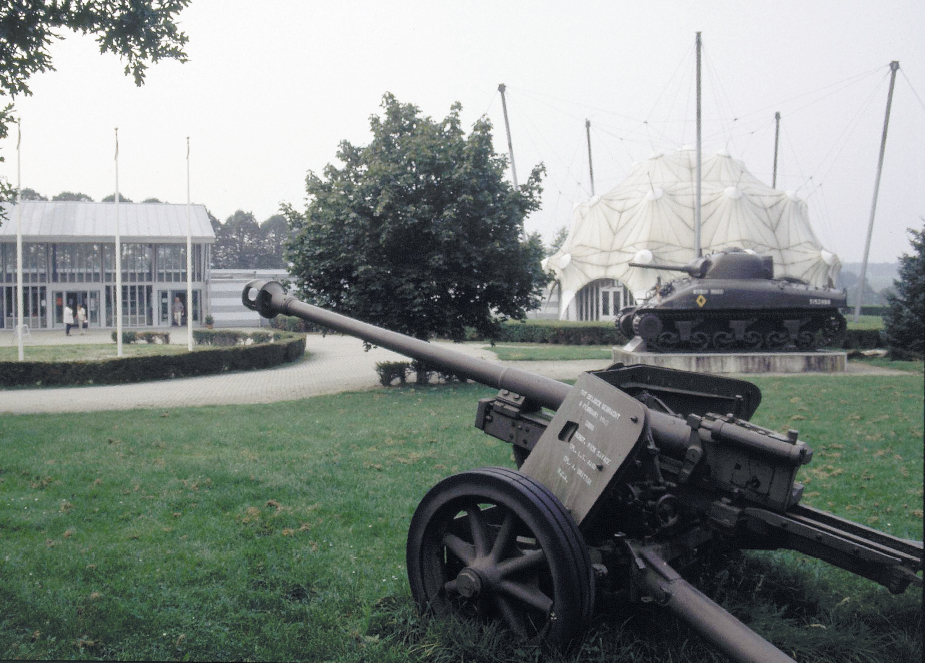
National Liberation Museum, Groesbeek: General view of exterior with German 75mm gun/Sherman Tank on Open Day/Detail of Waal Crossing Diorama
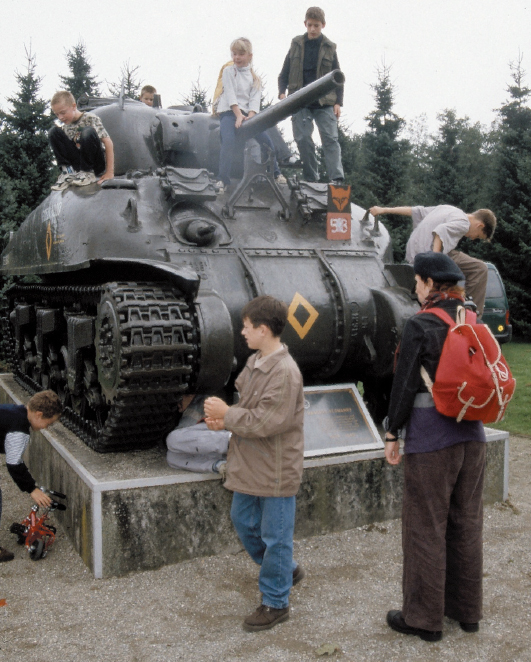
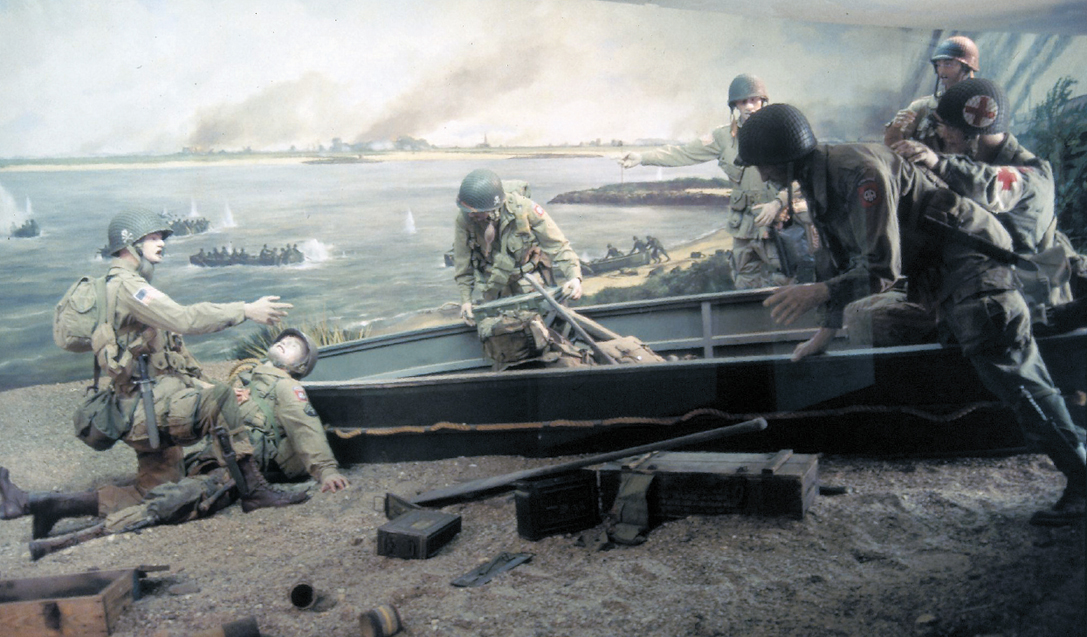
Finally there is the Hall of Remembrance, set in a striking building, shaped like a parachute. It contains the Roll of Honour with the names of every single American killed in MARKET. The names of British and Canadians killed in North-West Europe since 6 June 1944 are listed in books along the wall, under their divisional emblem. There are also books with the names of the Polish, Belgian and Dutch casualties.
This impressive museum also has a Film Room, an Education Room, a Documentation Centre and a bookstall and shop. The much-enlarged, smart cafeteria now has a huge panoramic window with views over DZ T and the February 1945 frontline.
Open: Monday-Saturday 1000-1700, Sundays and Public Holidays 1200-1700. Closed on Christmas Day and New Year’s Day.
Entrance fee payable, with concessions for groups, children and over-60s.
Tel: + (0) 24 3974404. www.bevrijdingsmuseum.nl. Address: Wylerbaan 4, 6561 KR Groesbeek.
In or adjoining the grounds are:
1. A Sherman tank, ‘Robin Hood’ T152098, presented on 7 May 1988 by the Notts Sherwood Rangers Yeomanry in memory of 208 of their comrades who fell ‘39-’45. The tank saw action in the Groesbeek area when the Sherwood Rangers worked with the US 508th PIR. At the end of September they moved into the Ooijpolder together and later fought in Operation VERITABLE in the Reichswald Forest and around Kleve.
2. German 75mm Pak 40 L/46 anti-tank gun, seized by Sergeant Mick Savage, Corporal L. S. Maso of the Welsh Guards and Corporal L. S. Britton, RCA, near Horst, just beyond the German border on 8 February 1945, the first day of Operation VERITABLE. This gun had shelled the Groesbeek area every day from Sepember 1944.
From the grounds, follow the path by foot to
3. The Canada-Netherlands Memorial Park.
On 5 May 1998 Princess Margriet of the Netherlands, in the presence of the Dutch Minister of Agriculture and Canadian Veterans, inaugurated this peaceful and reflective memorial to the shattering events of 1944-45. She also planted the tree which is enclosed by railings and bears a memorial plaque. The entire Dutch Royal Family was evacuated in May 1940 -despite an attempt by the Germans to capture them on 10 May - Queen Wilhelmina to London and Princess Juliana and Prince Bernhard to Canada, where Princess Margriet was born.
The Park is designed as a living monument for peaceful contemplation in the form of a wood of Canadian maples and a wild flower meadow enclosed by a hedge of field maple, hawthorn, spindle tree and dog rose, with views towards the Canadian Cemetery over the Drop Zones. The young wood is broken up by terraces (the flagstones of which bear the imprint of Canadian maple leaves) and stone benches.
Turn left out of the museum and continue to the T-junction.
In the car park by the T-junction is a medieval lookout tower housing a restaurant, locally known as The Old Mill. The mill stood there prior to September 1944 when it was hit by artillery and demolished during the winter of 1944-5. The bricks were used to reinforce local roads.
Turn left towards Groesbeek and take the first turning right into the town centre. Continue to the large roundabout beyond which is an old windmill. This is South Mill.
The mill, built in 1817, was used by the Underground as a beacon to help escaping airmen. In September 1944 US paratroops used it as an O.P. Today it is still working and can be visited by appointment. Tel: + (0) 24 3971283. Fax: + (0) 24 3977183 (Map 6/41).
Turn left, signed De Horst, and take the 2nd right on Rembrandtsweg and immediately stop by the memorial on the right.
• Memorial to Groesbeek’s Liberators, South Mill/24 kms/15 miles/5 minutes/Map 6/42
This stylized metal sculpture was erected in 1969 by Joep de Bekker. Its inscription, now missing, read, ‘Thanks to our Liberators, 1940-1945’.
In 1940 the inhabitants of villages along the threatened Meuse-Waal Canal were evacuated to Groesbeek. In October 1944, when Groesbeek was itself on the front line, all remaining inhabitants who had not already fled were evacuated.
Return to the roundabout and go straight over signed Mook on Mooksebaan. Continue to the group of small statues on the green on the left just before the right turn up Houtlaan.
• Groesbeek Evacuation Memorial/24.5 kms/15.3 miles/5 minutes/Map 6/40
This moving group was sculpted by Greet Norp-Nieuwhof, winner of the competition for an evacuation memorial. Inaugurated in September 1995, it depicts a family - father holding a child by the hand, mother pushing a baby in a pram and the grandfather - all bent forward in anxiety and exhaustion as they leave their home with barely any possessions. The caption translates, ‘The Second World War also brought much suffering to the civilians of Groesbeek. In September 1944 they had to flee from the cruelty of war. Here and elsewhere there were many victims. When they came back in the Spring of 1945 all their possessions were destroyed. The tanks and debris of war killed and wounded many people afterwards. The rebuilding of the village under harsh circumstances took many years. The civilians of today commemorate the civilians of yesteryear.’
Return to the roundabout, turn right signed Breedeweg. Continue on Bredeweg past the exit Groesbeek sign to the huge pink modern metal sculpture and turn left, stopping immediately at the information board in the layby just before the memorial group on the right.
• Memorial to General Gavin and 82nd US AB/25.8 kms/16.1 miles/10 minutes/Map 6/43
On 5 May 1987 the original star-shaped plaque by Kees Hectors was laid on the ground and the road to the right was named General Gaavinstraat (sic). The inscription is
Out of gratitude and respect of the population of Groesbeek for the American 82nd Airborne Division, which under command of General James M. Gavin liberated Groesbeek from terror and suppression on 17 September 1944.
On 12 June 1994 walls were added by the Groesbeek Airborne Friends with a plaque bearing the words, ‘James M. Gavin, Commanding General US 82nd Airborne Division ‘All American’. Mission accomplished. After Action Report. Market Holland Operation, sep-nov [sic] 1944.’ This was unveiled by General Gavin’s grand-daughter, Mrs. J. E. Gavin, and veterans. On 17 September 1994, the 50th Anniversary, para and glider symbols were added. On 17 September 1997 the monument was ‘entrusted to all who believe in peace’ in the presence of veterans. The trees in the surrounding garden were planted by individuals and bear their names on plaques.
Return to the pink sculpture, turn left onto Bredeweg and take the next turning left on Koningin Wilhelminaweg. Continue to the memorial on the left at the end of the row of houses.
• Memorial to General Browning’s HQ 17.9.44/26.7 kms/16.7 miles/5 minutes/Map 6/44
Erected on 16 September 1990 by C. Hectors, A. van Grinsven and Father Thuring (qv), the inscription reads,
The British Airborne Corps headquarters under General ‘Boy’ Browning landed here on 17 Sept 1944 with Horsa gliders as their winged horses. Pilgrim, let love lend you wings when necessary.
The thirty-eight gliders landed in the middle of the battle area at about 1400 hours and the command post, with a staff of 105, complete with radio transmitters and receivers, was operational at 1530 hours. An apocryphal story is that the General walked to the border [about a mile from here - a good walk!], urinated against a tree and said, ‘I’m the first British soldier to pee on Germany!’
Return to Bredeweg, turn left and continue to the church on the right and stop.
The area to the right of the road behind the houses is Klein Amerika, DZ N for 505th PIR, which follows next.
Walk to the base of the church tower.
• St Anthony’s Church Memorials/27.2 kmsl 17 miles/5 minutes/Map 6/45
On the tower are 6 plaques, sculpted by Niels Steenbergen, funded by the Groesbeek- Nijmegen Airborne Friends and erected on 13 June 1979. They are in memory of soldiers of the 505th PIR killed or missing in action on DZ/LZ N (near Klein Amerika) September-November 1944. One is to Captain Anthony Stefanich, C Coy 505th PIR, who was killed in action on 18.9.44 near Hof Sint Jansberg (qv) when he tried to rescue the crew of a glider that had crashed on enemy-occupied territory. Others commemorated are Guy E. Belcher, Alpheus E. Fowlkes, Kenneth H. Lau and Sonnie J. Rockford, killed along the Tree Row (qv) and Roger F. Coffin, Stanley Creswick, Raymond Dionne, Walter Faranfontoff, Russel O. Eade and J. P. Shelton, killed at Plasmolen, from where attacks on Mook and the lockbridge at Heumen were repulsed. Other soldiers of the Regiment fell near Den Heuvel (qv) where they were stationed from 20 September.
The Pastor of the church, Father Thuring (a long-time friend of ours), is an expert on the battle, an author of many authoritative books on the Campaign and a member of the Committee for the Groesbeek National Liberation Museum.
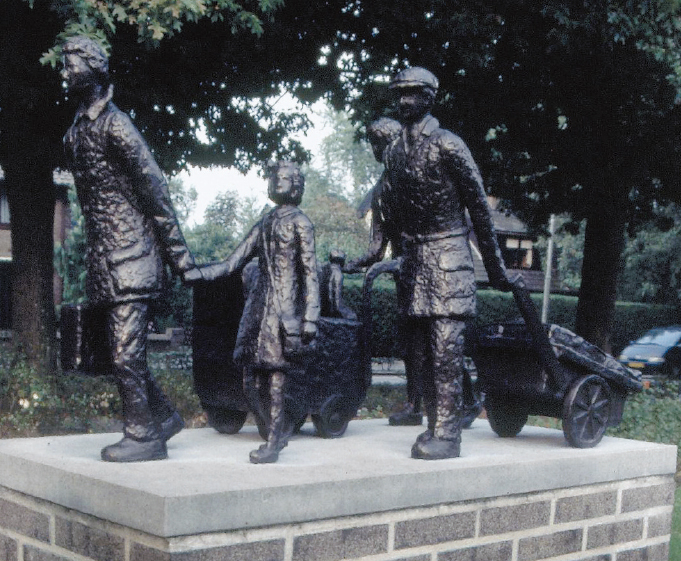
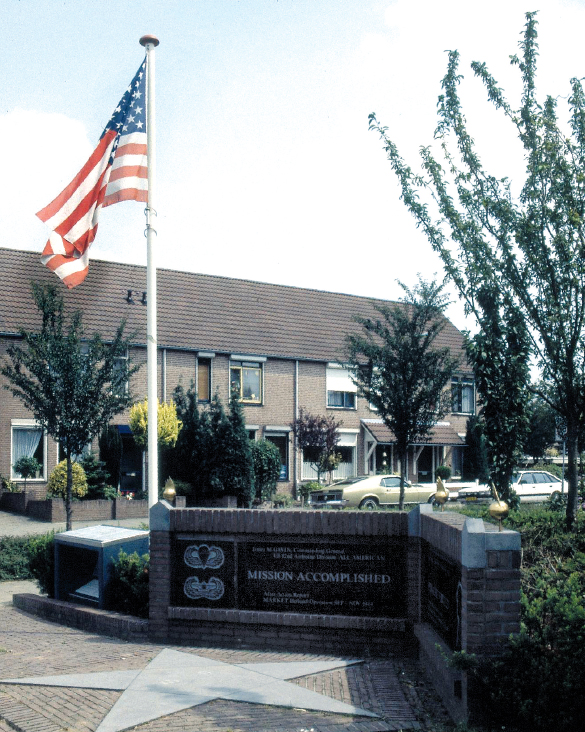
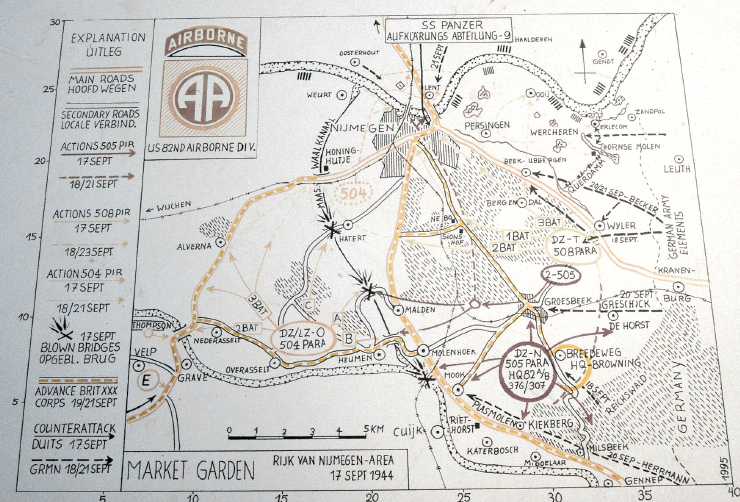
Memorial to Gen Gavin and 82nd AB Div, Groesbeek with detail of Map
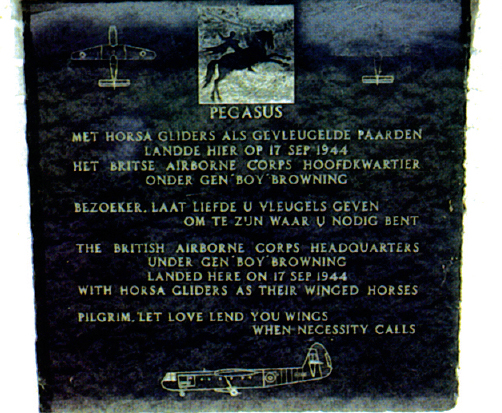
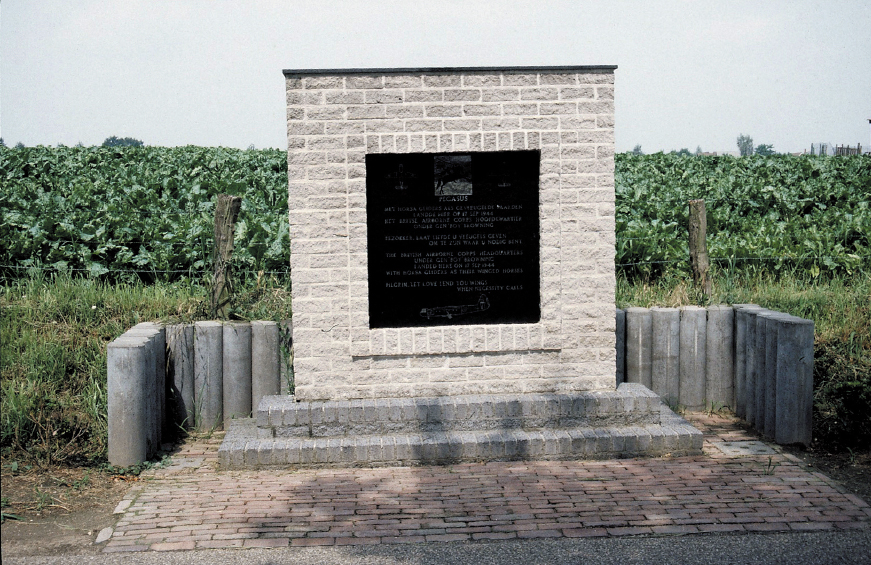
Memorial to Gen Browning’s HQ with detail, Breedeweg
Continue round the church on Sint Antoniusweg and as the road bends sharply left, take the minor road straight on signed Klein Amerika.
The tree-lined hedge to the left is all that remains of the infamous Tree Row. In 1944 the line of trees continued right to the forest.
Just before the farm on the right, bear right along Klein Amerika and follow this uphill to the double memorial on the right-hand side.
You are now at the southern end of DZ N.

Plaque to Capt Stefanich Sint Antonius Church
• Memorials to the 505th PIR DZ, 17/18.9. 44 and General Crerar’s 1st Can Army 1945/29.1 kms/18.2 miles/5 minutes/Map 6-47/46
The double memorial was erected by C. Hectors, A van Grinsven and Father Thuring on 16 September 1990. The left-hand tablet records that
With Europe in peril, Paras landed here in their thousands. General James Gavin and the All American Division 17 & 18 Sep 1944 Operation Market Garden. Pilgrim, are you, like the liberators, ready to lay down your life when your fellows need you.
In the night of the 16th and the morning of the 17th the landings were preceded by massive bombardments on German air bases, barracks, anti-aircraft artillery and flak positions. At Klein Amerika, DZ N, 2,291 men of the 505th PIR landed with the HQ of 82nd AB Division. General James Gavin and his staff landed at about 1315 hours in the field straight ahead at the top of the road. The wood ahead appears triangular in form and was easily recognized from the air. Here Divisional RV was set up after the jump.

Memorial to 505th PIR and Gen Crerar’s 1st Can Army with detail, Klein Amerika

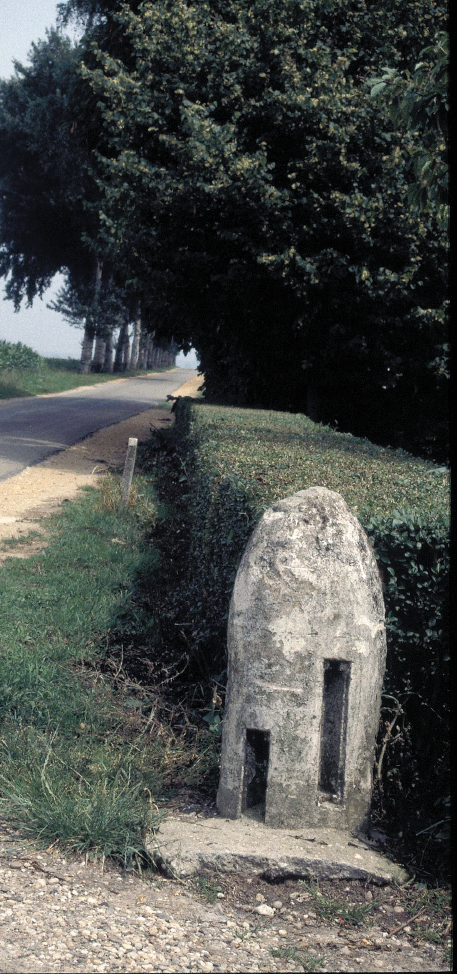
Concrete bomb, Klein Amerika
The right hand tablet records,
Here in the winter of 1944/45 tens of thousands of soldiers of Crerar’s First Canadian Army held the front line between the Maas and the Waal. Pilgrim, cherish all you hold dear.
The Canadians held what became the front-line here at that time.
The memorials bear some fine pictures of a C-47 Troop Carrier, a Jeep, a GM Ford 3 Ton Lorry and a Carrier.
Continue, following the metalled road round to the right, to the group of houses on the right.
In front of the house, named Klein Amerika, are German concrete practice bombs found in the bomb depot at Mooksbaan in the forest to the left when the local evacuees returned in the spring of 1945. (Map 6/48)
Continue to the pink statue on Bredewcg.
You have now effectively made a circuit of DZ N.
Turn right towards the church. Continue past the church and past the turning to Klein Amerika and take the next turning right on the minor road Sint Jansberg. Continue to the green post box of house no 1. Turn left up the track before it.
NB. This is a private house and permission should be requested to photograph the memorial.
• Plaque to Crew of Halifax, Sint Jansberg/33.6 kms/21 miles/5 minutes/Map 6/49
Erected on 17 September 1977 by H. van den Hoogen, it commemorates the crew of a Halifax of 87 Squadron killed when their plane was brought down near this spot on 12/13 March 1943. It was one of 23 aircraft brought down during the second air raid of more than 450 bombers on the steel industry town of Essen. From 1941 the Germans took all British and Commonwealth pilots killed in this area to Uden where they were buried, after investigation, in the back garden of the parsonage. After the war more than 100 graves were moved from the garden to the Uden CWGC Cemetery (qv). Listed here are Flight Sergeant Fred Marean, RCAF, Sergeant Harry Bentley, RAF, Sergeant Charley Dyer, RAF, Sergeant William McLelland, RAF, Sergeant Walter Gosnell, RAFVR, Sergeant Bernard Singleton, RAFVR, and Sergeant George Benson, RAFVR.
Return to the main road and turn right along Grafwegen. Continue as the road skirts the Reichswald Forest. Its left-hand edge is the German border.
There are bunkers in the Forest dating from 1917 and a narrow gauge railway was made to assist in their construction, built when, on declaration of unrestricted U-boat warfare, Germany, who had no reserves in the area, feared that neutral countries would enter the war. The railway was used by forestry workers in the 20s and 30s and was destroyed during MARKET-GARDEN.
Continue past the playing fields on the right and almost immediately stop just before a sign to ‘Zandwinning Tuinen’ (sandpit) opposite house No 44. Look in the ditch on the left.
• Royal Pioneer Corps and Other Units 1945 Monument, Milsbeek/37 kms/23.1 miles/5 minutes/Map 1N/4
This rare wartime monument was constructed by Royal Engineers in the area on 2 March 1945. The three stones bear the coats of arms of 2nd British Army (a cross on a shield) the Royal Corps of Pioneers, with the motto ‘Labour conquers everything’, and 707 Road Construction Company. It was restored by the District Water Board in the spring of 1989. The memorials commemorate Operation VERITABLE which began at 1030 hours on 8 February 1945. Because of the large numbers of vehicles that would be involved and the very wet weather, it was necessary substantially to improve the roads, a task requiring engineers and pioneers. The job was given to 13 AGRE who brought up as much as 600 tons a day of stone from Belgium. This was the area of assault of 51st Highland Division, attacking approximately from your right to your left. They faced a German anti-tank ditch and minefield which roughly ran along the edge of the forest.
Another RE memorial had been erected by 179 Special Field Coy on 23 August 1944 in the Normandy village of Tierceville. It is in the form of a gilded statue of Eros.
Continue into Milsbeek. Turn right on the N271 and immediately right just before the traffic lights towards Milsbeek Centrum. Continue over a series of sleeping policemen to the church and stop. Just past it is a green CWGC sign to the Cemetery to the left. Stop on the left and walk to the cemetery.
• Milsbeek CWGC Cemetery/38.7 kms/24.2 miles/15 minutes/Map 1N/5
This is the smallest CWGC Cemetery in the area. There are 210 burials, all British Army except 1 RM Commando and 1 RAAF. The majority are from February and March 1945 during the advance into Germany during Operation VERITABLE, but some are from September 1944. They include men from the 51st (Highland) Division, the 52nd (Lowland) Division and the 3rd Battalion, Irish Guards.
The MM was awarded to Driver Charles Cole, RASC, 22 September 1944 [II.D.12.]; Serjeant William Dunlop 1st Gordon Highlanders age 25, 13 February 1945 [II.G.12.] and Corporal Arthur Townsend, 5th HLI, age 20,16 February 1945 [LA.13.].
Walk towards the T-junction ahead to the memorial on the left corner.
• Milsbeek Civilian Memorial/38.7 kms/24.2 miles/5 minutes/Map 1N/6
The memorial bears the names of twenty-one inhabitants of Milsbeek who were killed during the war - as a consequence of forced labour, in concentration camps and other acts of war.
Return to the N271 and turn right. Continue to Plasmolen.
The village and the hills to the right were the scene of much bitter fighting on 20/21 and 27 September onwards when 325th Glider Infantry Regiment tried to take the Kiekberg Woods but ran into tenacious German defences.
Continue through Plasmolen (where there is a group of attractive restaurants) to Mook.
The village of Mook was taken by parachutists of the 505th PIR (82nd AB Division) on 17 September 1944. On 20 September two of Kurt Student’s German combat teams attempted to break into the American lines both here and around Beek and Wyler. General Gavin, who had been at the Maas River planning, with Reuben Tucker, the assault crossing scheduled for later that day, rushed from place to place encouraging his troops and while in Mook actually took part in a small arms action against the Germans. Assessing Mook as the greatest danger point, he reinforced Colonel Ekman’s 505th with some Coldstream Guards and 300 glider pilots and the position held.

Plaque to Crew of Halifax, St Jansberg


1945 Memorials to Royal Pioneer Corps and 707 Road Construction Coy, Milsbeek
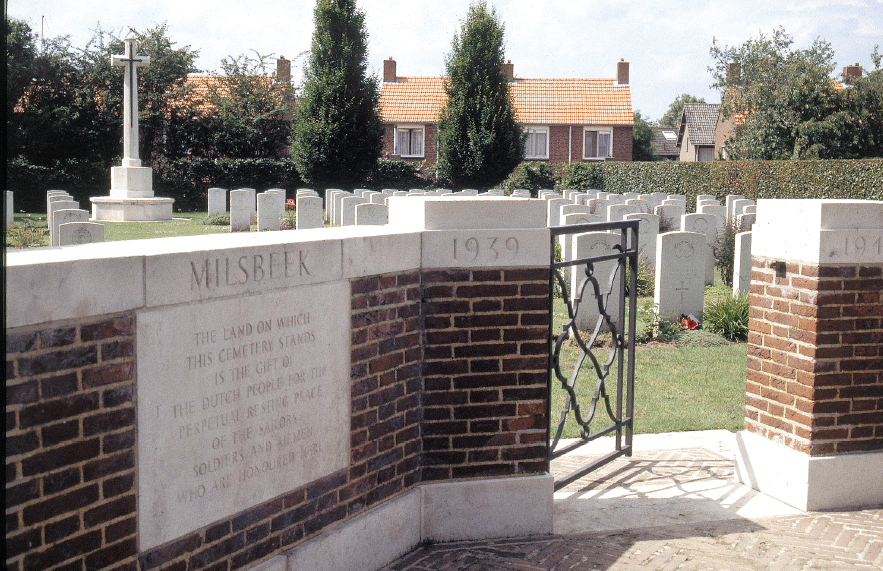
Milsbeek: CWGC Cemetery and Civilian Memorial
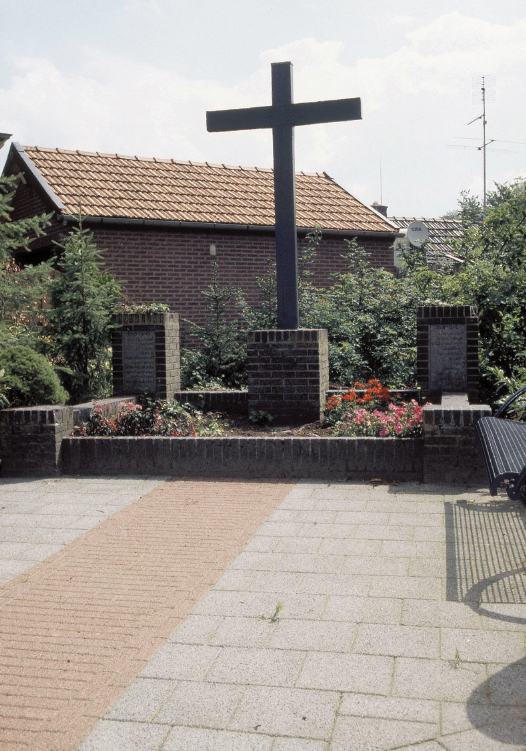
Enter Mook and 300m before the traffic lights turn right, signed to the CWGC Cemetery. Continue over sleeping policemen to a T-junction. Turn right again following the CWGC sign and stop immediately on the left.
• Mook CWGC Cemetery/45 kms/28.1 miles/15 minutes/Map 6/21
This is a most beautifully designed cemetery, with a graceful grassed approach and the rows of graves leading up, past the Cross of Sacrifice, to the shelter at the top of the slope. It contains 322 burials, mostly from the fighting nearby in September/October 1944 or during the advance into Germany in February 1945. Casualties in the intervening period were from artillery and patrol activity. There are 3 RN, 276 named and 11 Unknown UK Army, 3 Canadian and 3 Canadian Unknown, 11 Polish, 6 RAF and 1 Unknown, 4 RCAF, 3 RAAF and 1 RNZAF.
To walk along the rows of headstones reading the private messages seems particularly poignant here. For example the grave (which bears no religious emblem) of Sapper J. C. Woodhall, RE, age 22, 17 February 1944, [1.A.16.] reads, ‘Into the mosaic of Victory I place this priceless jewel - my only son.’ Major Edward Andrews, 1st HLI, age 23, 2 March 1945 [I.B.I.], was awarded the MC. The personal inscription on his headstone reads, ‘One who never turned his back but marched breast forward’. The Welsh inscription on the grave of R. Hughes, RWF, age 25, 24 February 1945 [1.B.12.], Heb un cledd Canu wnawn mewn hedd yn y nefoedd dawel, translates ‘Without a sword we shall sing in peace in the tranquil heaven.’
Lieutenant Anthony Paget, 1st Ox and Bucks, age 20, 5 March 1945 [I.C.12.], was awarded the DSO, the Croix de Guerre and was MiD. He was the son of General Sir Bernard Paget, KCB, DSO, MC. Private Jon Adams, 4th KOSB, age 19,18 February 1945 [II.C.15.], was awarded the DCM. Lieutenant-Colonel George Dickson, Commanding the 7th RWF, age 30, 6 March 1945, [1.C.14.] was awarded the DSO.
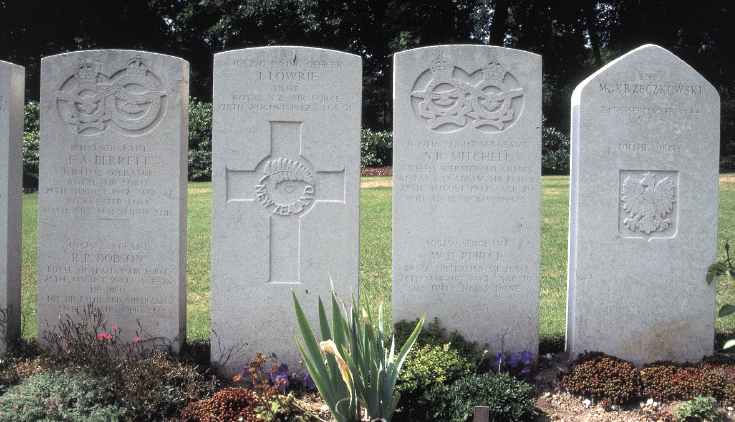
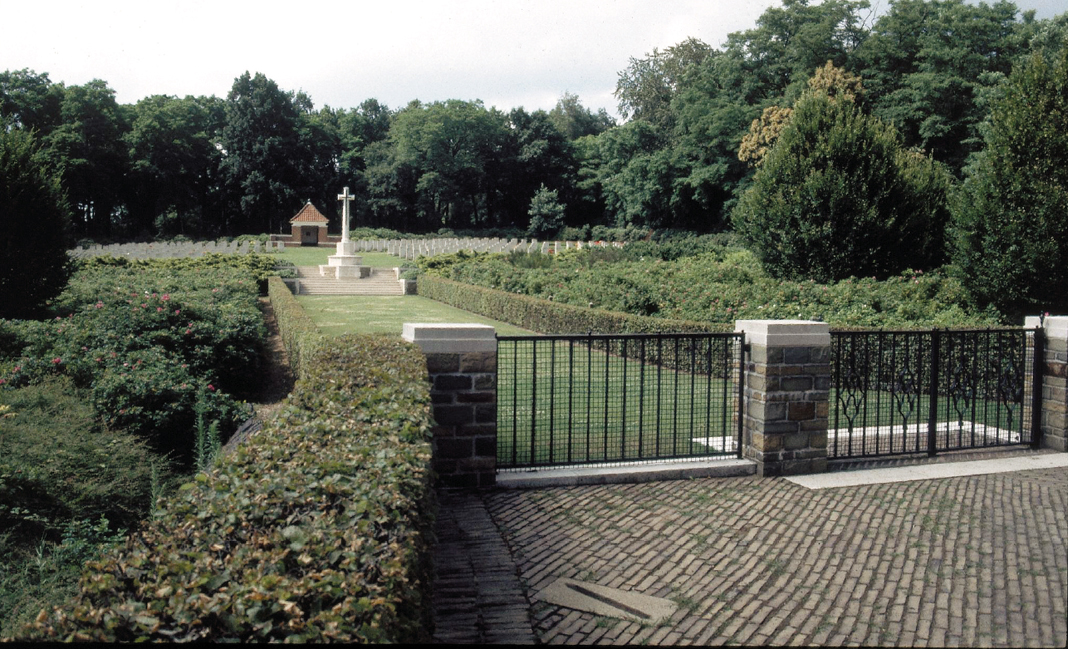
Mook CWGC Cemetery and headstones to an Aircrew and Polish Pte Krzeczowski
The twin brother of Private Percival Ayres, 7th Hants, age 21, 28 March 1945 [H.B.3.], Private Wilfred Ayres, 1st Hants, age 20, 6 June 1944, is buried in Bayeux Cemetery. The brother of Serjeant Arthur Dudley, 2nd KSLI, age 35, 7 October 1944 [I.E.IO.], Acfn George Dudley, age 20,19 August 1940, is buried in Chelmarsh (St Peter) Churchyard, Salop.
Private Leonard Osborne, 2nd R Warwicks, 5 March 1945, was only 17 [I.C.ll.]. Buried together in 4.C. and all bearing the same date, 28 August 1942, is the aircrew Mitchell and Peirce, Berrelt and Dobson (in 2 joint graves) and between them Lowrie. Next to them is the Polish headstone of Strzelec (Private) Mieczyslaw Krzeczowski, 24 September 1944, who was killed in Oosterbeek and for some reason buried here with the inscription ‘T. Cjczyzno’. This name could not be traced in Polish records but in 1988 Jan Lorys, one of Sosabowski’s Staff Captains and a leading light in the Polish ex-Service community in London, explained to us that this meant ‘For You My country’. With the help of his service number Krzeczkowski was finally identified and the headstone changed.
As in many of the Allied war cemeteries, individual graves here were ‘adopted’ by local people when the temporary crosses were changed to the standard headstone.
Walk over the road to the local cemetery and descend towards the right-hand wall of the cemetery. On the second row from the bottom is
• Memorial to Mook Civilians killed on 19-20.9.44/45 kms/28.1 miles/10 minutes/Map 6/22
In the fierce fighting around Mook in September 1944 the town hall, parsonage, schools and many other buildings were destroyed and eight inhabitants were killed. Five were hit by shellbursts in the shelters where they hid, three were hit when they tried to rescue livestock from their burning homes. By the evening of 20 September almost all the inhabitants had fled, only to return to their damaged village in April 1945. The memorial lists their names and bears the words of the poet, L. de Bourbon, which translate:
Victims of man’s idle struggle
No more blossom did their eyes see on earth
But for the party God preserved for them
Flowers will be in bloom perpetually.
The road at the bottom of the cemetery is called General Gavinstraat.
Turn round and drive straight down to the traffic lights on the N271. Go straight over the road and park near the church and the VVV.
• Mook-en-Middelaar Roman Catholic Churchyard/45.4 kms/28.4 miles/5 minutes/Map 6/20
On the south of the church is the grave of Private Eric Holmes, 1st Suffolks, age 19,8 October 1944.
Turn left along the N271 towards Nijmegen and continue under the railway.
The railway line goes over the Maas to the left. On 17 September 505th PIR, moving up from DZ N, reached the bridge only to find that the Germans had blown it.
Continue to Molenhoek.
On the right is theVan derValk Motel de Molenhoek with excellent food. Tel: + (0) 24 3580155.
Just before the Motel turn left on the small road Molenstraat and stop by the memorial on the right by house No. 10.
• Site of Allied Wartime Cemetery, Van den Broek Brewery/47.7 kms 129.8 miles/5 minutes/Map 6/17
From 20 September 1944 the Allies buried their dead behind the nearby former brewery. The monument, unveiled on 17 September 1984 in the presence of General Gavin with prayers by the Rev George B. Wood, who parachuted into Groesbeek on 17 September as a divisional chaplain, commemorates 637 ‘gallant soldiers and airmen of the United States and British armed forces in the fall and winter of 1944 they gave their lives to liberate the Netherlands of Nazi tyranny’. In fact there were 836 burials here. All Saints’ Day was celebrated here on 2 November 1944 in the cemetery which was closed four years later. A full description of this major cemetery, with the names of all originally buried here, and the circumstances of their death when known, can be found in Vanished (Temp) Cemeteries (qv) by Father Thuring and J. Hey. The Americans were repatriated or reburied in Margraten US Cemetery (qv) and the forty-one British and Commonwealth soldiers were reburied in Mook CWGC Cemetery (qv). The members of C Coy 307th AB Engineers originally buried here were killed rowing paratroopers across the Waal.
Return to the N271 and turn left towards Nijmegen. Continue to the junction with the N844 signed to Nijmegen to the right.

Memorial to site of Temp. Cemetery, Van den Broek Brewery, Molenhoek
• Extra Visits to Statue to Cuijk Civilians (Map 1N/2) and Jewish Memorial (Map 1N/3); Katwijk Dutch Soldiers Memorial (Map 6-18/19) and Memorial to James Martin and Crew of crashed C-47, Linden (Map 6/6). Round trip approximately 26.4 kms/16.5 miles. Approximate time: 60 minutes
Take the N271 bridge over the Maas-Waal Canal and turn right onto the A73/E31 motorway direction Venlo. Take the first exit (No 4) to Cuijk, signed 2kms to the left on the N321. Continue to the roundabout. Turn right signed Vanen and then immediately left signed to Cuijk on a cyclists’ sign. Cross the railway line (8.8 kms/5.5 miles) and immediately turn right on Parallelweg. Continue to the Station on the right and park.
Opposite the station is a Statue of the Good Samaritan (9.1 kms/5.7 miles) sculpted by an anonymous Polish artist. It was presented to the town by the Association of Dutch present and former Shock Troopers to commemorate the inhabitants of Cuijk killed in the war. The statue has an interesting history. It was made from a piece of stone from the Berlin Reichstag and was originally destined as a gift for Pope Pius XII. The Russians would not open their zone border and, with the help of the Dutch director of the Charity Mission in Berlin, the statue found its way here and was erected on 28 July 1956. A pillar standing by the sculpture bears a plaque commemorating the Shock Troopers of Cuijk fallen 1946-1996. In 2000 there appeared to be something missing from the top of the pillar.
Continue, bearing left following the one-way system on Veldweg, Fraterstraat to the T-junction at Grotestraat. The VVV is then signed to the left. Turn right and immediately left on the short road Maasveld to the road which runs along the Maas. Turn left towards the large church and stop just before it.
Against the wall of the former synagogue on the left is the Memorial to the Jewish Inhabitants of Cuijk (10.1kms/6.3 miles) - twenty in number at the outbreak of war. Seven of them went underground, but the others were deported - the last four leaving on 9 April 1943 for the concentration camp at Vught (qv). All died in camps at Auschwitz, Sobibor or Vught. The memorial lists thirteen victims, with the camps in which they died. All were of the Cohen or Andriesse families. The memorial, by E. Hermans and erected on 2 May 1985, asks us to Remember and reflect on those who ‘were taken away from us because they were Jews’.
Turn right under the bridge and left along the banks of the Maas signed Mook. Follow signs, turning right, into Katwijk. Turn right at the Y fork and drive to the banks of the Maas.
The Monument to 24 Dutch Soldiers on the right (13 kms/8.1 miles) is a 7-metre high sandstone obelisk, designed by A. M. van Breugel and erected on 17 July 1947. The soldiers were killed defending the sector of the ‘Meuse Line’ from Katwijk to the railway bridge near Gennep. Captain B. Hueting, who was commander of the company that was billeted in Cuijk in 1940, was one of the instigators of the monument. The inscription, which lists all the 24-1 Captain, 5 Sergeants, 9 Corporals and 9 soldiers, reads,
From the citizens of Cuijk and surrounding districts, 2nd Battalion - 26 R.I. and P. T. Corps - to their comrades who fell on May 10th 1940 doing their duty in the unequal fight against the German conqueror.
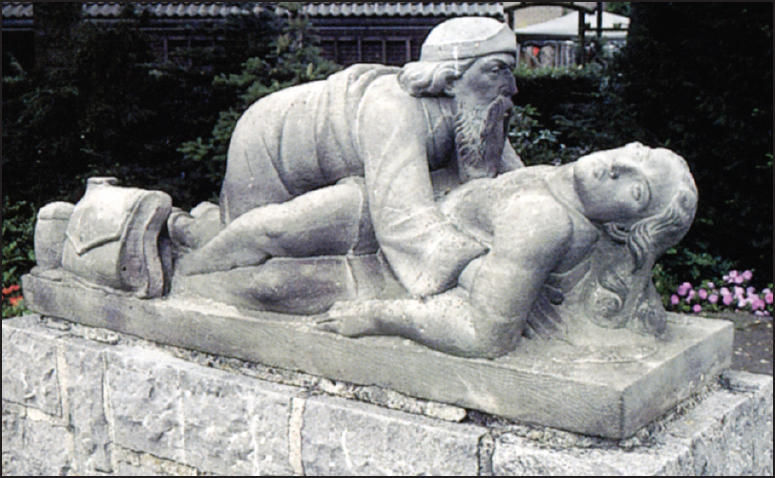
Cuijk: Memorials to Civilians and old Jewish Synagogue

The border region of the Netherlands had been mobilized on the Italian invasion of Albania on 10 April 1939. Full mobilization took place on 29 August 1939.
The railway bridge visible to the left is the Molenhoek Bridge, blown by the Germans on 17 September.
Turn round and go first right on Mariagaarde.
On the Mariagaarde churchyard to the right is a Dutch Wargraves sign. It relates to the graves of three Corporals of the 2nd Battalion, 26th Infantry Regiment in the cemetery.
Continue under the railway and over the water following signs to Linden past the Achtkant Stelling Mill on the right. Turn left, go straight over the next junction and under the A73 motorway. Continue to the church in Linden. Park and enter the churchyard.
Inside the wall to the left is a plaque to the crew of a C-47 (16.5 kms/10.3 miles). The caption reads, ‘Pray for the souls of James Martin and his comrades, fallen in this place on September 17th 1944.’ Nobody now knows who erected this touching memorial.
On that day twelve series of forty-five C-47 Skytrains passed over carrying paratroopers to Groesbeek. Some of the slower planes were hit from positions on the Meuse-Waal Canal and the railway bridge near Mook. They all continued to fly in formation towards their DZs. One of the planes hit was being flown by James Martin. Nevertheless he managed to drop all his paratroops but one near the Wylerbaan (qv) and the plane crashed here. The five members of the crew were killed and Martin received a posthumous Flying Cross for his brave action. He is buried in Jefferson Barracks, St Louis, Missouri in common grave 84/153-155.
Turn round, return under the motorway and at the 1st junction turn right to Cuijk and Nijmegen.
On the left is the handily situated Van der Valk Hotel de Cuijk with café and restaurant. Tel: + (0) 485 335123.
Enter the A73 motorway direction Nijmegen. Take the first Exit (No 3) to Malden on the N271 and rejoin the main Itinerary (26.4 kms/16.5 miles).
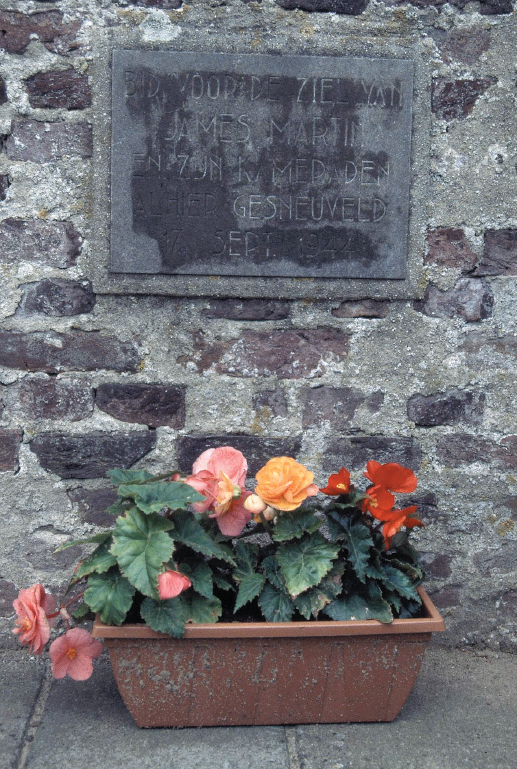
Cuijk: Memorials to Civilians and old Jewish Synagogue
Do not continue on the N271 but turn right and continue through Malden on Rijksweg then St Annastraat. Continue to the next traffic lights.
• Extra Visits to the Hospitals of the 82nd (Map 6/12) and 101st AB Division (Map 6/9). Round trip approximately 4.5 kms/3.1 miles. Approximate time: 10 minutes.
Turn right at the second traffic lights onto Houtlaan and continue some 300m to the massive monastery building on the left.
This is the Berchmanianum, used in September 1944 as the 82nd AB Divisional Hospital. Today it is a Retirement Home and a prior appointment must be made to visit it. Tel: + (0) 24 3838485. Fax: + (0) 24 3558712.
Continue to the roundabout, turn left and take the 1st street to the left after the tall multi-story building (Erasmuslaan) and follow it until it rejoins Annastraat. Turn right and continue to the 6th traffic light and turn left on Groenestraat. Turn left at the traffic lights on Dobbelmannweg.
There is a big church on the left. The vestry behind the church and the school on the left are all that remain of the buildings used as the 101st AB Hospital from late September 1944 and during their period on The Island when 2,765 casualties were treated. The Hospital was plainly marked as such but on 29 October the Germans bombed it, killing three Medics and wounding six.
Continue to the traffic lights at the crossroads with Hatertseweg and turn left. Continue to the junction with St Annastraat and pick up the main itinerary.
Continue to Keizer Karel Plein. Take the 1st exit to Centrum on Oranjesingel back to Keizer Traianus Plein, Nijmegen (57 kms/35.5 miles).
• End of Itinerary Three

2 bikes, 4 passengers

Cycles at Eindhoven Station
